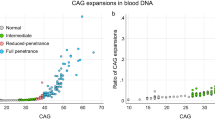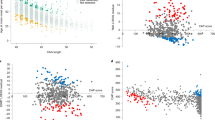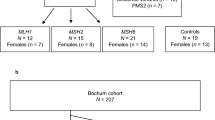Abstract
Six inherited neurodegenerative diseases are caused by a CAG/polyglutamine expansion, including spinal and bulbar muscular atrophy (SBMA)1, Huntington's disease (HD)2, spinocerebellar ataxia type 1 (SCA1)3, dentatorubral pallidoluysian atrophy (DRPLA)4,5 Machado-Joseph disease (MJD or SCAB)6 and SCA27–9. Normal and expanded HD allele sizes of 6–39 and 35–121 repeats have been reported10–13, and the allele distributions for the other diseases are comparable. Intergenerational instability has been described in all cases, and repeats tend to be more unstable on paternal transmission. This may present as larger increases on paternal inheritance as in HD14, or as a tendency to increase on male and decrease on female transmission as in SCA1 (ref. 15). Somatic repeat instability is also apparent and appears most pronounced in the CNS16,17. The major exception is the cerebellum, which in HD, DRPLA, SCA1 and MJD has a smaller repeat relative to the other brain regions tested16–21. Of non-CNS tissues, instability was observed in blood, liver, kidney and colon16,20,21. A mouse model of CAG repeat instability would be helpful in unravelling its molecular basis although an absence of CAG repeat instability in transgenic mice has so far been reported. These studies include (CAG)45 in the androgen receptor cDNA22, (CAG)44 in the HD cDNA23, (CAG)82 in the SCA1 cDNA24, (CAG)79 in the SCA3 cDNA andas an isolated (CAG)79 tract25.
This is a preview of subscription content, access via your institution
Access options
Subscribe to this journal
Receive 12 print issues and online access
$209.00 per year
only $17.42 per issue
Buy this article
- Purchase on Springer Link
- Instant access to full article PDF
Prices may be subject to local taxes which are calculated during checkout
Similar content being viewed by others
References
La Spada, A.R., Wilson, E.M., Lubahn, D.B., Harding, A.E. & Fischbeck, K.H. Androgen receptor gene mutations in X-linked spinal and bulbar muscular atrophy. Nature 352, 77–79 (1991).
HDCRG. A novel gene containing a trinucleotide repeat that is unstable on Huntington's disease chromosomes. Cell 72, 971–983 (1993).
Orr, H.T. et al. Expansion of an unstable trinucleotide CAG repeat in spinocerebellar ataxia type 1. Nature Genet. 4, 221–226 (1993).
Koide, R. et al. Unstable expansion of CAG repeat in hereditary dentatorubral-pallidoluysian atrophy (DRPLA). Nature Genet. 6, 9–13 (1994).
Nagafuchi, S. et al. Dentatorubral and pallidoluysian atrophy expansion of an unstable CAG trinucleotide on chromosome 12p. Nature Genet. 6, 14–18 (1994).
Kawaguchi, Y. et al. CAG expansions in a novel gene for Machado-Joseph disease at chromosome 14q32.1. Nature Genet. 8, 221–228 (1994).
Imbert, G. et al. Cloning of the gene for spinocerebellar ataxia 2 reveals a locus with high sensitivity to expanded CAG/glutamine repeats. Nature Genet. 14, 285–291 (1996).
Pulst, S.-M. et al. Moderate expansion of a normally biallelic trinucleotide repeat in spinocerebellar ataxia type 2. Nature Genet. 14, 269–276 (1996).
Sampei, K. et al. Identification of the spinocerebellar ataxia type 2 gene using a direct identification of repeat expansion and cloning technique, DIRECT. Nature Genet. 14, 277–284 (1996).
Stine, O.C. et al. Correlation between the onset age of Huntington's disease and length of the trinucleotide repeat in IT-15. Hum. Mol. Genet. 2, 1547–1549 (1993).
Rubinsztein, D.C. et al. Phenotypic characterisation of individuals with 30–40 CAG repeats in the Huntington's disease (HD) gene reveals HD cases with 36 repeats and apparently normal elderly individuals with 36–39 repeats. Am. J. Hum. Genet. 59, 16–22 (1996).
Barron, L. H. et al. A study of the Huntington's disease associated trinucleotide repeat in the Scottish population. J. Med. Genet. 30, 1003–1007 (1993).
Andrew, S.E. et al. The relationship between trinucleotide (CAG) repeat length and the clinical features of Huntington's disease. Nature Genet. 4, 398–403 (1993).
Duyao, M. et al. Trinucleotide repeat length instability and age of onset in Huntington's disease. Nature Genet. 4, 387–392 (1993).
Chung, M. et al. Evidence for a mechanism predisposing to intergenerational CAG repeat instability in spinocerebellar ataxia type 1. Nature Genet. 5, 254–258 (1993).
Telenius, H. et al. Somatic and gonadal mosaicism of the Huntington disease gene CAG repeat in brain and sperm. Nature Genet. 6, 409–413 (1994).
Ueno, S. et al. Somatic mosaicism of CAG repeat in dentatorubral-pallidoluysian atrophy (DRPLA). Hum. Mol. Genet. 4, 663–666 (1995).
Aronin, N. et al. CAG expansion affects the expression of mutant huntingtin in the Huntington's disease brain. Neuron 15, 1193–1201 (1995).
Chong, S.S. et al. Gametic and somatic tissue-specific heterogeneity of the expanded SCA1 CAG repeat in spinocerebellar ataxia type 1. Nature Genet. 10, 344–350 (1995).
Takano, H. et al. Somatic mosaicism of expanded CAG repeats in brains of patients with dentatorubral-pallidoluysian atrophy: cellular population-dependent dynamics of mitotic instability. Am. J. Hum. Genet. 58, 1212–1222 (1996).
Tanaka, F. et al. Differential pattern of tissue-specific somatic mosaicism of expanded CAG trinucleotide repeat in dentatorubral-pallidoluysian atrophy, Machado-Joseph disease, and X-linked recessive spinal and bulbar muscular atrophy. J. Neurol. Sci. 135, 43–50 (1996).
Bingham, P.M. et al. Stability of an expanded trinucleotide repeat in the androgen receptor gene in transgenic mice. Nature Genet. 9, 191–196 (1995).
Goldberg, Y.P. et al. Absence of the disease phenotype and intergenerational stability of the CAG repeat in transgenic mice expressing the human Huntington's disease transcript. Hum. Mol. Genet. 5, 177–185 (1996).
Burright, E.N. et al. SCA1 transgenic mice: a model for neurodegeration caused by an expanded CAG trinucleotide repeat. Cell 82, 937–948 (1995).
Ikeda, H. et al. Expanded polyglutamine in the Machado-Joseph disease protein induces cell death in vitro and in vivo. Nature Genet. 13, 196–202 (1996).
Mangiarini, L. et al. Exon 1 of the Huntington's disease gene containing a highly expanded CAG repeat is sufficient to cause a progressive neurological phenotype in transgenic mice. Cell 87, 497–506 (1996).
Krawczak, M. et al. Covariate-dependent age-at-onset distributions for Huntington's disease. Am. J. Hum. Genet. 49, 735–745 (1991).
Farrer, L.A., Cupples, L.A., Kiely, D.K., Conneally, P.M. .& Myers, R.H. Inverse relationship between age at onset of Huntington's disease and paternal age suggests involvement of genetic imprinting. Am. J. Hum. Genet. 50, 528–535 (1992).
Hogan, B., Beddington, R., Constantini, F. & Lacy, E. Manipulating the mouse embryo, a laboratory manual. (Cold Spring Harbor Press, New York, 1994).
Riess, O., Noerremoelle, A., Soerensen, S.A. & Epplen, J.T. Improved PCR conditions for the stretch of (CAG)n repeats causing Huntington's disease. Hum. Mol. Genet. 2, 637 (1993).
Author information
Authors and Affiliations
Corresponding author
Rights and permissions
About this article
Cite this article
Mangiarini, L., Sathasivam, K., Mahal, A. et al. Instability of highly expanded CAG repeats in mice transgenic for the Huntington's disease mutation. Nat Genet 15, 197–200 (1997). https://doi.org/10.1038/ng0297-197
Received:
Accepted:
Issue Date:
DOI: https://doi.org/10.1038/ng0297-197
This article is cited by
-
Neuropathogenesis-on-chips for neurodegenerative diseases
Nature Communications (2024)
-
Redox dysregulation as a driver for DNA damage and its relationship to neurodegenerative diseases
Translational Neurodegeneration (2023)
-
Suppression of trinucleotide repeat expansion in spermatogenic cells in Huntington’s disease
Journal of Assisted Reproduction and Genetics (2022)
-
A slipped-CAG DNA-binding small molecule induces trinucleotide-repeat contractions in vivo
Nature Genetics (2020)
-
Early Detection of Apathetic Phenotypes in Huntington’s Disease Knock-in Mice Using Open Source Tools
Scientific Reports (2018)



